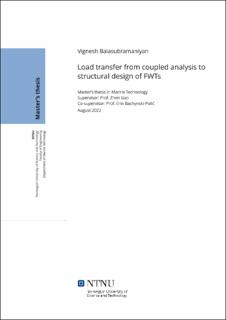| dc.description.abstract | It is of research interest to establish a technique to capture the loads on the structural members of the offshore wind turbine when they are exposed to simultaneous wind and wave action. Unlike other floating offshore structures, which are dominated by wave loads, offshore wind turbines are subjected to wind turbine loads in addition to the wave loads. In this thesis, simultaneous wind and wave action (called the coupled domain) results in wind turbine loads like thrust and torque in addition to wave loads. The thesis aims to demonstrate a procedure to include the wind, wave, inertia, and effects from the tower and mooring system on the offshore wind turbine and estimate the loads on the cross-section of the pontoon of an offshore wind turbine.
Most current numerical solutions cannot handle both coupled analysis and load transfer. For example, most analyses assume the floater as a rigid body and perform coupled analysis using numerical tools like SIMA. Numerical tools like SIMA, which can handle coupled analysis, do not facilitate obtaining the cross-section load on a rigid body. The thesis addresses the challenge of handling coupled analysis and load transfer for a floating offshore wind structure. This thesis work proposes using three different numerical tools, SIMA, WASIM, and WADAM, to attain the goal of the thesis. SIMA can handle coupled analysis, but cross-sectional loads on a rigid body cannot be obtained in SIMA. WASIM and WADAM can obtain cross-sectional loads on a rigid body. The goal of the thesis is attained by using these tools in conjunction. This thesis work is divided into three stages. In stage one, the model used in SIMA, WASIM, and WADAM are validated by comparing the hydrodynamic properties of the three models. In stage two, the proposed approach in this thesis work is validated in regular wave analysis. In stage three, coupled analysis of the floater is executed, and cross-sectional loads on the pontoons are obtained. Further, the rigid body model used in the thesis is compared with a flexible body model developed by NTNU Master's Student Mr. Yu Ma. A flexible body model is a multi-body representation of the FOWT modeled in SIMA, and loads of the flexible body model are obtained in SIMA.
The validation of the proposed approach resulted in reasonably consistent results. The resonance zone exhibited discrepancies which are attributed to the differences in non-linear damping properties in the WADAM, WASIM, and SIMA models. The proposed approach to obtaining the loads in this thesis is relevant to obtaining the loads on a structure parallel to the global axes in the numerical tools. The proposed approach cannot be used to obtain the loads on the structure which are not parallel to the global axes. Comparing the rigid body model with the flexible body model was consistent for the axial loads but displayed huge variations for bending moments. The discrepancies in the comparative study between rigid and flexible body models must be further investigated. If the flexible body and rigid body approach results are consistent, the flexible body approach will be a one-stop solution to estimate loads on a structural member in a coupled domain. The flexible body approach has no restriction regarding the orientation of structural members, unlike the rigid body approach, where the structural members must be parallel to the global axes. | |
